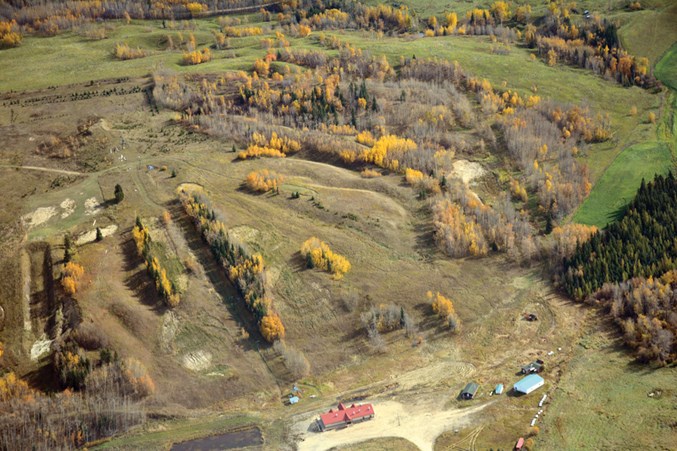With the June 11 deadline for proposals to either purchase or manage the Tawatinaw Valley Ski Hill approaching, two parties toured the facilities last month and are readying proposals for Westlock County.
Following an April 10 in-camera session, councillors voted unanimously to seek out expressions of interest from the public to either lease or purchase the facility. County residents voted 1,028-866 to sell the facility during an October 2017 plebiscite, though a majority of Division 7 residents — where the hill is located — voted to keep it.
“They attended the mandatory site visit to be a qualified applicant,” explained chief administrative officer Leo Ludwig following the May 7 and 14 tours.
“A facility like that, you want to make sure if someone is making a proposal they’ve actually been on site and have an idea what the facility entails. It’s a fairly complex set of infrastructure.”
Current hill operator DK Consulting and the Friends of the Tawatinaw Valley, a group of former members of the Tawatinaw Valley Alpine Nordic Centre Advisory Board, toured the ski hill, chalet and other facilities.
Both parties are tight-lipped on what their proposals will contain, but both expressed a desire to keep it open.
“I haven’t really decided how I’m going to do that yet. We have to look at all the options and decide which way is the best,” said DK Consulting owner Dom Kriangkum.
“We’ve run it for the last two years and I would like to think we did a good job for the community. It’s a lot of fun.”
Friends of Tawatinaw Valley spokesperson Heather Toporowski said they’re still doing their homework, though her research suggests expanding the hill’s users.
“Right now, our focus has been thinking what needs to go into the EOI. We’ve been in touch with comparable ski facilities about what success factors are and what is important to go into the foundation of our plan,” she said.
“We need to take into consideration all the various user-needs. We would love to build it as a family-focused operation and really want to encourage young people to have an option for recreation in the area.”
She noted her group will take a grassroots approach to the hill and would reach out to other stakeholders.
“Our first rule of business would be to connect with partners, like the schools and nearby First Nations that have been running cross-country skiing periodically at the hill,” she said.
“We really need to connect with families to make sure we know what kind of programming they need. We want to make this a facility that is open to everybody.”
One successful venture she’s heard from several successful similar-sized ski hills, including Grande Prairie and Kinosoo Ridge near Bonnyville, is expanding both winter operations to include sports other than skiing and then moving into other seasons, such as mountain biking.
“We need to start thinking of it more as a multi-season recreation facility versus just skiing,” she said.
“We also have learned from some other ski hills how they maximize their snow making and efficiencies on their winter programs. Tawatinaw Valley is a jewel. It has a beautiful chalet, there’s lots of recreation happening in the area and there’s a lot of opportunity.”
Whoever takes over the hill has their work cut out for them. The Tawatinaw Valley Alpine Nordic Centre Advisory Board handed operations over to Westlock County council in 2008, but the ski hill had already been losing money since at least 2006.
Documents included in the EOI package note that the hill lost $4,000 in 2006, which snowballed to $79,578.91 in 2007 and $56,753.96 in 2008.
After council took over the hill, the net loss skyrocketed to $142,248.59 in 2009 and hovered in six-digit losses until 2014, when the hill registered a net loss of $39,247.21.
It was all downhill from there — in 2015 the hill brought in $274,014.42 while spending $628,380.30 — a net loss of $354,365.88. In 2016 and 2017 the hill has managed to keep expenses to $248,125.49 and $278,931.74 respectively, but in those same years only made $41,580.60 and $5,475.80 last year, resulting in more net losses.
Between 2006 and 2017, the hill made $1,883,311.76 and cost $3,781,465.87, resulting in a loss of $1,898,154.11.
Neither party is kidding themselves on expecting to make a lot of money. Kriangkum admitted he was involved because of his love for the area and Toporowski noted that running rural recreational facilities is more of a public service.
“Having said that, having a non-profit group involved opens opportunities for income streams like fundraising, grants and corporate partnerships, which offset the costs of running it. We want to make it affordable for people,” she said. “It comes down to how do we operate it as efficiently as we can and how do we make sure we are good stewards of the resources that are there.”
A number of groups, including the Tawatinaw Free Riders Freestyle skiing club, make use of the facility, with skiers coming from as far away as Beaumont to use the hill. Currently the ski hill employs 25 people. A Feb. 27 presentation from former members from the Tawatinaw Valley Alpine Nordic Centre Advisory Board estimated the hill needed to have 60 users a day all year round to be sustainable.
“In either case, the ski hill is still going to be there,” said Kriangkum. “It’s to the benefit of the community, regardless of what the outcome of the EOI is.”



